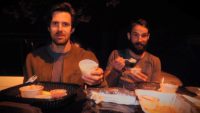Spoiler Warning! MAJOR spoilers ahead for Season 4 of Stranger Things, right up to the final episode. Continue reading at your own risk.
For the more athletic, popular kids at school, the sports team of their choice is probably a rather significant aspect of teenage life. The reserved, nerdier kids are more likely to gravitate towards a different kind of social game, the most famous of which is Dungeons and Dragons (D&D for short). I’d say this is still relevant today, but with less choice around in the 1980s, the two activities would have been obvious hobbies in that era.
Stranger Things Season 4 explores the epic highs and lows of high school basketball and D&D in tandem with one another. In the first episode, “The Hellfire Club,” a particular scene makes the comparison explicit, having a basketball game intercut with an end-of-campaign D&D session. Narratively and technically, the scene is well-executed, addressing some key themes of the season.
First of all, there is some visual contrast between the two games. In the classroom where the Hellfire Club are playing D&D, the lighting is lower. It’s dark and dingy, the only source of light being from candles placed around atmospherically. A dark wooden table is a centerpiece, and the Dungeon Master (DM), Eddie Munson, sits upon a carved wooden throne. This very much reflects the medieval fantasy setting D&D takes place in, as it comes across as archaic. In contrast, the school gym where the basketball game takes place is brightly lit, polished, and clean. Fluorescent lights reflecting off the lightly coloured floor and walls give a shiny, modern feel to the environment.
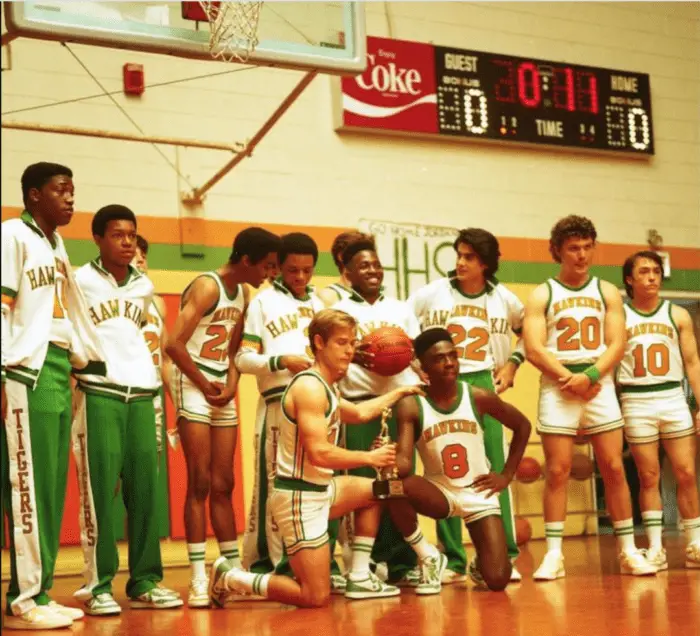
The costumes of both scenes also support the dark vs light theme. The D&D players are dressed in rather dark, muted colours. Even the white Hellfire Club T-shirts have black sleeves and an alternative design. On the other hand, the sportswear of the basketball players involves white vest tops and shorts, with accents of bright colours like yellow and green. These different types of dress are rather typical of nerd/metalhead vs. jock expression, separating the two social groups.
Another difference between the two games is the level of physical activity. To play D&D, only imagination is required for any form of movement, so players remain sat down. Obviously, a sports game involves a lot of running around, so is much more kinetic than a board game. However, as the D&D session gets more intense, the players do end up standing and moving around in their excitement. Despite the conflicting reasons for this movement, perhaps this shows that the two games aren’t all that different.
On that note, intercutting the scenes together creates many parallels between D&D and basketball. Eddie’s opening line that sets the scene is “the hooded cultists chant,” and soon after we see shots of the basketball crowd chanting and cheering for their team. ‘Cultists’ is too strong a word to apply to sports fans, but the group dynamic, shared goal, and actively voicing support for their team/leader are all things they have in common. In regards to the structure of the basketball team and D&D party themselves, Eddie as the DM holds a similar position to the basketball coach in terms of guiding the players and supporting them in their battle to win against their opponents.
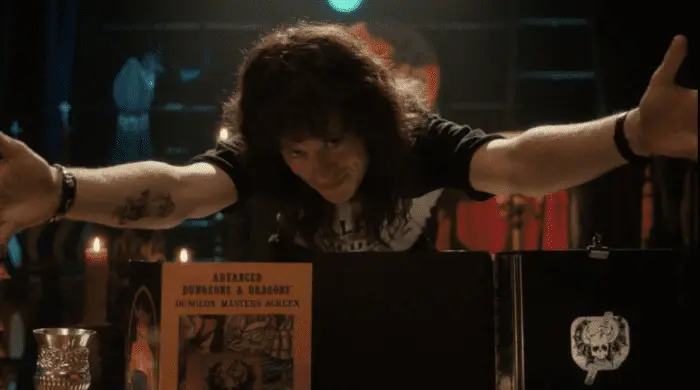
While Eddie narrates the state of the party—”You are scared. You are tired. You are injured.” We see one of the basketball players getting carried off the court by his friends as he limps. D&D ‘injuries’ are imagined, based on losing hit points, as opposed to real-life, physical injuries, but the heightened emotional state of players in both situations is the same. There are ups and downs in both games, including these times when the outcome isn’t looking ideal, and an attempt to continue seems futile. At this point, Eddie asks the players if they flee or stand and fight while Lucas Sinclair gets called on to play despite looking unprepared and nervous. In spite of the odds, there is hope for both parties. Both lots of players show courage and persistence.
During the montage of gameplay, a few direct comparisons are made. Involvement of numbers is one of them; we see a shot of the digital scoreboard, then dice being rolled. D&D players cheer in response to high rolls while the sports crowd cheers for their team’s increasing score. Equally, a player rolls low and we get a comparative shot of a basketball missing the hoop. Dice rolls are entirely luck-based as opposed to shooting hoops, which is based on athletic skill, but the outcome is the same.
When both games are looking rough for our protagonists, each party calls for a “time-out.” The two teams huddle and discuss tactics in a very similar manner. Jason Carver, the main basketball jock, says “just get me the ball,” closely followed by Dustin Henderson, a main authority in his party, saying “give me the D20.” Both characters can be considered leaders who often instigate the first move, both in-game and in the overall narrative of the show. The slow-motion camera kicks in and the music stops as both guys shoot their shots. We hear the heightened sounds of the basketball bouncing off the hoop and the dice rattling as Dustin prepares to roll. They both miss.
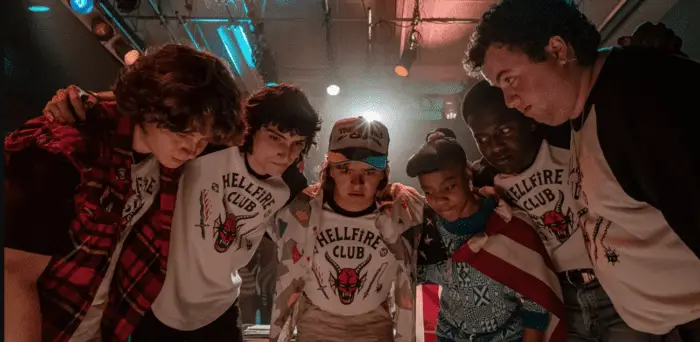
As Jason and Dustin’s moves fail, we hear the sound of Vecna’s clock striking. Throughout Season 4, this sound functions as a leitmotif, connoting the feeling of dread in the face of impending danger. Using it in this scene emphasises the stakes of both games, showing how seriously the kids are taking these recreational activities. D&D and basketball respectively should be the most intense event in their teenage lives, as is the case for any regular teenager. This sadly isn’t the case, considering the dangerous supernatural goings-on they’ve had to deal with in Hawkins over the years. The juxtaposition of these normal school kids’ games with the threat of the Upside Down and all its monsters is rather tragic on reflection, as it highlights how much these kids have to deal with when they should just be playing games and hanging out with friends. All the students of Hawkins have this in common, whether they’re sports jocks or D&D nerds. All have been endangered by the Upside Down, and all have lost loved ones as a result. They are unified by both their fun and their troubles.
Back to the games—siblings Lucas and Erica Sinclair end up saving both situations. Lucas scores right before the timer runs out, and Erica rolls a natural 20, dealing a critical blow to Vecna. All the supporting characters cheer for the dual victory, including applauding Lucas and Erica. To conclude the D&D session, Eddie says, “That’s why we play.” This statement easily applies to both games and even the wider situation of battling monsters from the Upside Down. Even when things get rough, being brave and fighting the good fight ensures that the heroes come out on top in the end, and it’s all the more satisfying because of the struggle. In a general theme of the show, this is how the kids deal with impending doom. To quote “Detroit Rock City” by Kiss, the song playing in the background of this very scene, “I got to laugh ’cause I know I’m gonna die.” The inevitability of death and suffering means you have to enjoy the fun times even more, and take things lightly. Cue celebratory upbeat synth music!
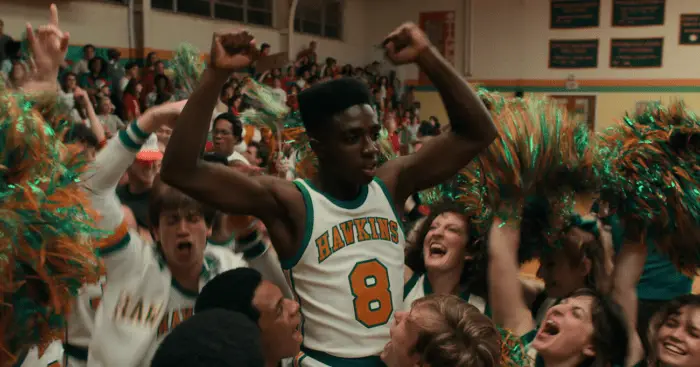
As well as these surface-level themes of the D&D/basketball scene, there’s a significant amount of foreshadowing for the remainder of Season 4, in retrospect. More lyrics of the aforementioned background song, “Detroit Rock City,” are relevant to specific plot points and more general themes of the season. For example, “I hear my song and it pulls me through,” which essentially spells out word-for-word how to escape Vecna, as we discover in Episode 4, “Dear Billy.” Once Vecna’s trapped victim hears their favourite song, they can ‘pull through’ and find a way back to reality. The story of the song itself is about an imminent car crash, which we later discover is the source of Fred Benson’s trauma: being in a car accident that killed his friend.
As another key nugget of foreshadowing, Eddie gives some advice to his players via an NPC: “There’s no shame in running.” Many characters end up having to flee situations throughout Season 4, such as Jonathan, Will, Argyle, and Mike who run from the military and end up on the road, and Max literally running away from Vecna (while “Running up That Hill” by Kate Bush plays, nonetheless). Most importantly, this advice is what Eddie himself follows for a long time, as his natural reaction is to run away from any sign of trouble; he spends most of the season in hiding after being accused of Chrissy’s murder. In fact, the reason Eddie ends up dying in “The Piggyback” is that he finally chooses not to run. His earlier advice was clearly masking his own insecurities, as he faces his fears by standing his ground and fighting to help the others.
Since the start of Stranger Things, each monster the heroes face have been named after D&D creatures and villains, and Vecna is no different. Therefore, it’s not much of a reach to say the events of the D&D session foreshadow what happens in the fight against Upside Down Vecna. Eddie kicks off the session by revealing that Vecna isn’t dead, as the players thought. This could reflect how Eleven assumed that Number One was dead, but wasn’t, and turned out to be Vecna. Additionally, the group believes they’ve defeated Vecna in the final episode, but it turns out he’s still alive. Now, Eddie also specifies that Vecna is back with one arm and one eye—could this be the case with Vecna in Season 5? We don’t see him at the end of the season, so he could well have sustained these injuries.
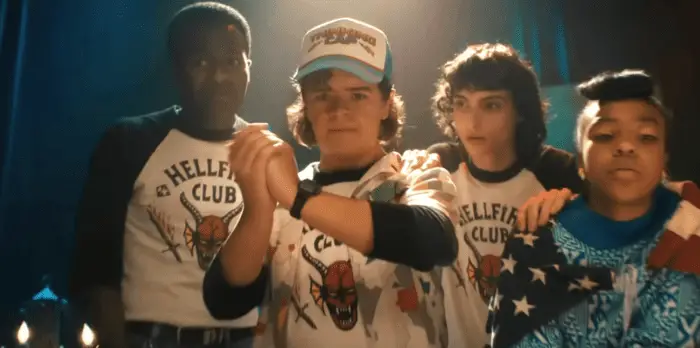
All-in-all, the D&D basketball scene highlights that, contradicting popular belief, there are many more similarities between the two games than there are differences. The obvious, high-school commentary reading of this is that nerds and jocks have more in common than they think. How very Breakfast Club. At a basic narrative level, the intercutting gives a reason for all these characters to be in the same scene while not physically with each other. Therefore, our core characters are brought together in a logical way; Lucas, Steve, Nancy, and Robin are involved in the basketball scene, where Eddie, Dustin, Mike, and Erica are the centre of D&D. On closer inspection, the parallel plots unify the teenage experience.
In a season saturated with tragedy, it’s nice having a light-hearted scene as well. These teens deserve some fun! Considering the trauma they’ve all had to deal with over the seasons, it’s sad when you realise playing basketball and D&D should be the norm for them, and that it’s so out of the ordinary to not be in life-threatening danger. But like I’ve said, the fun is necessary for coping with the hard times. That’s why we play, right?


